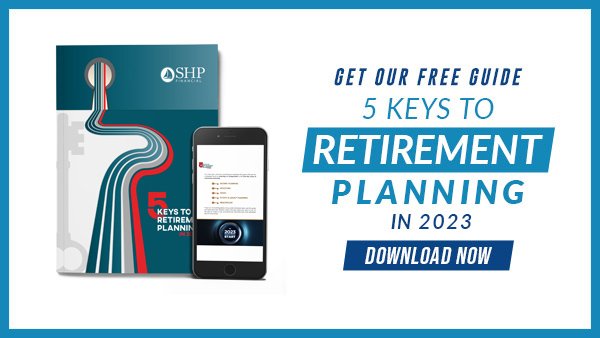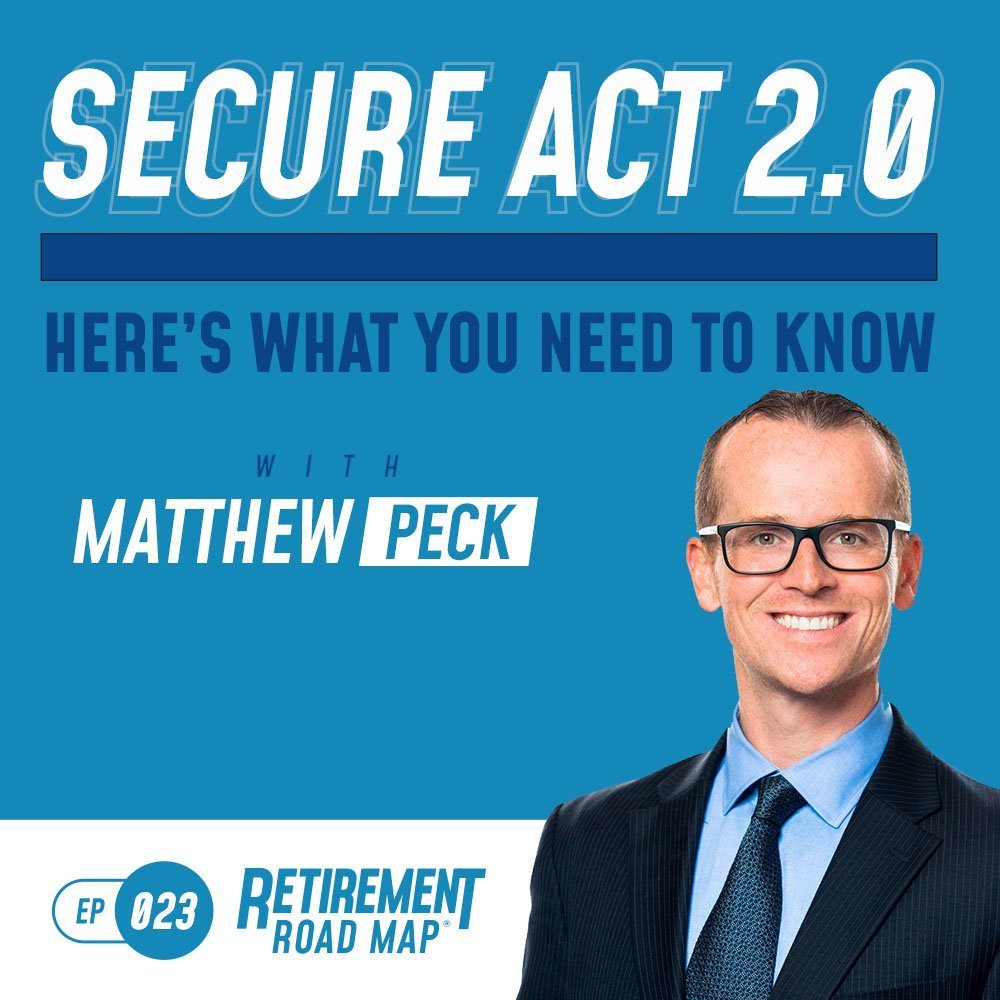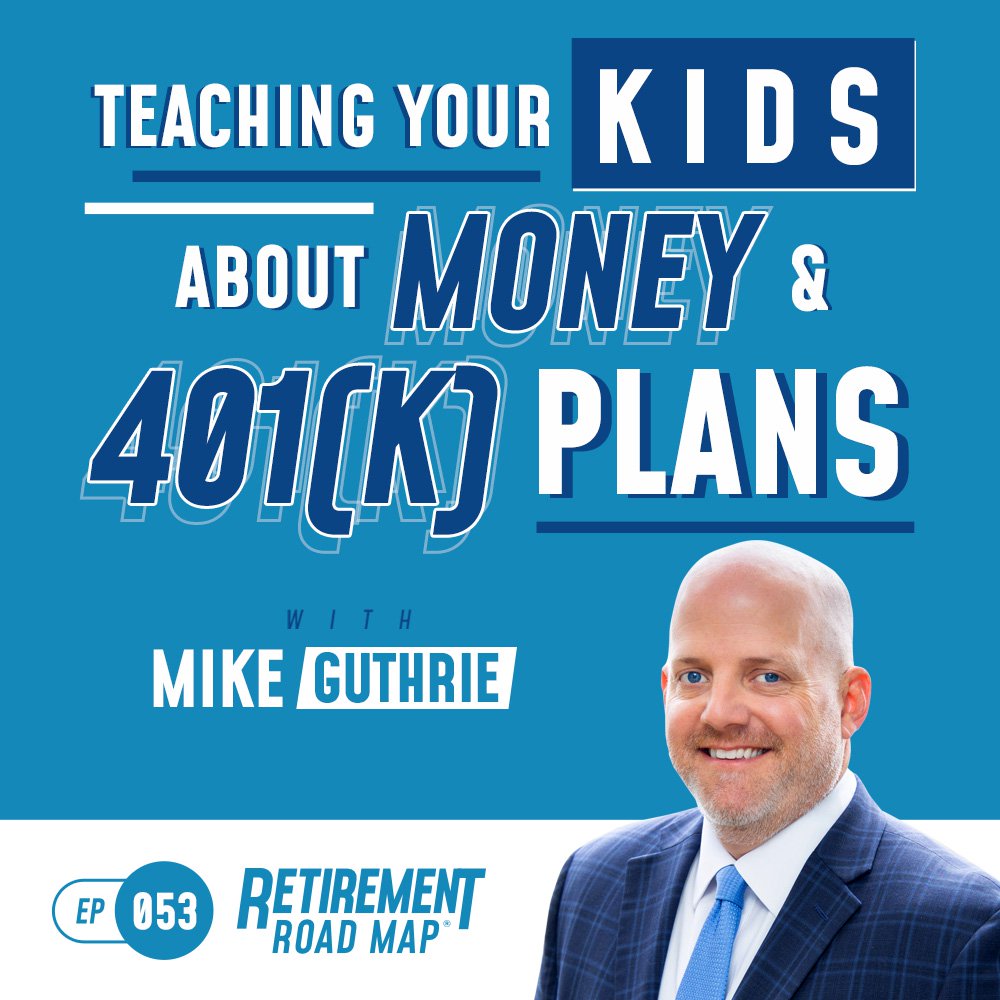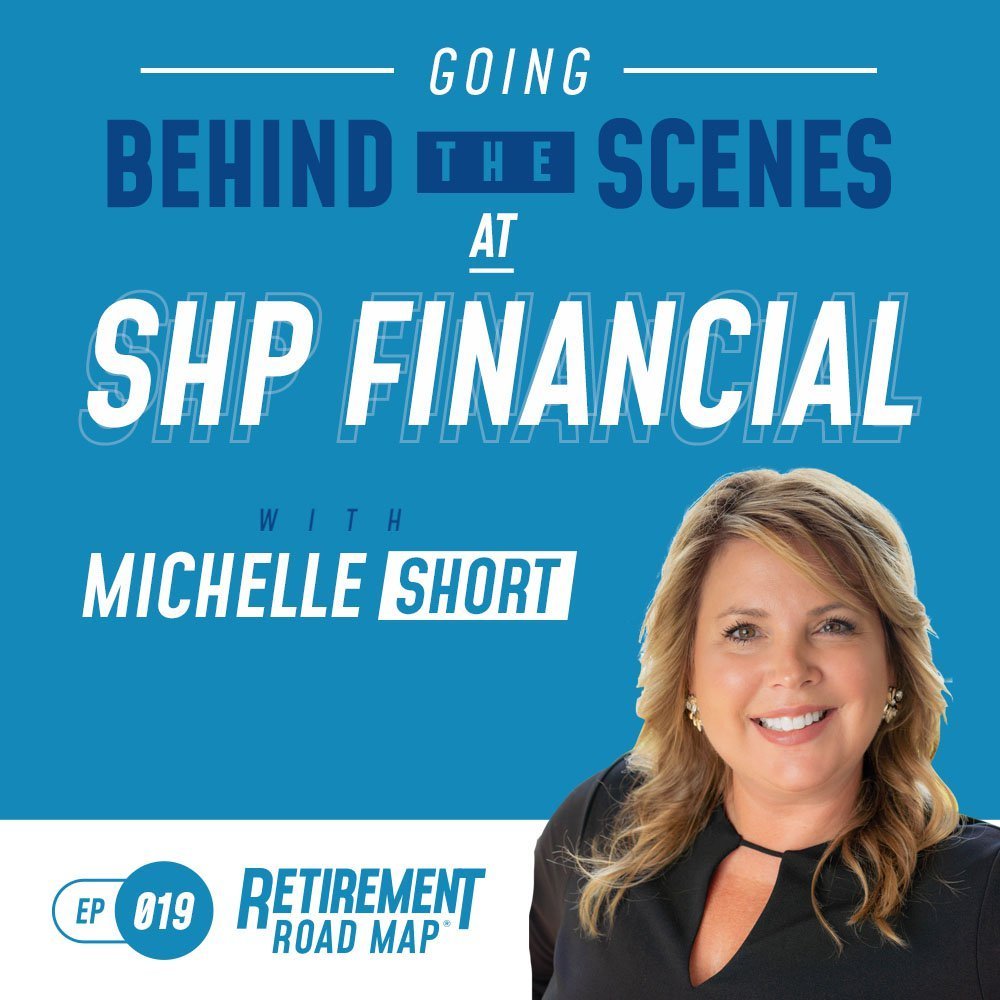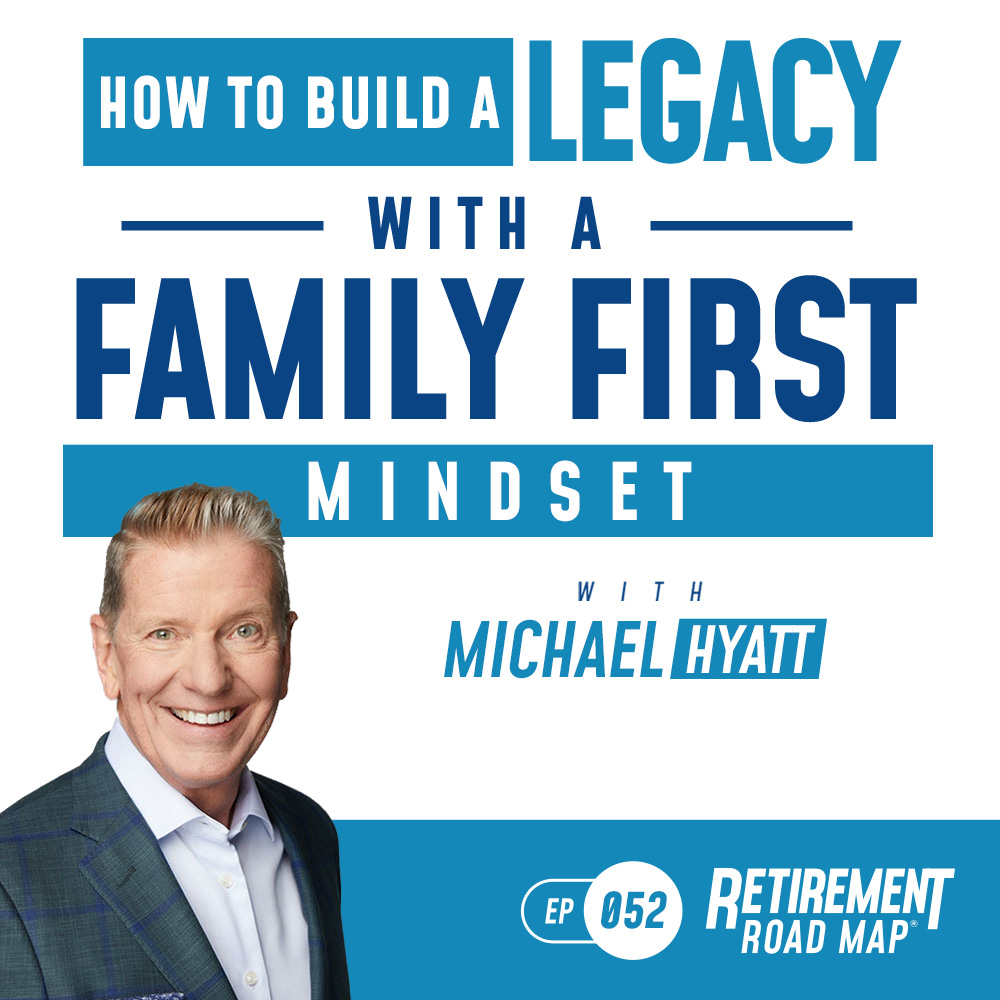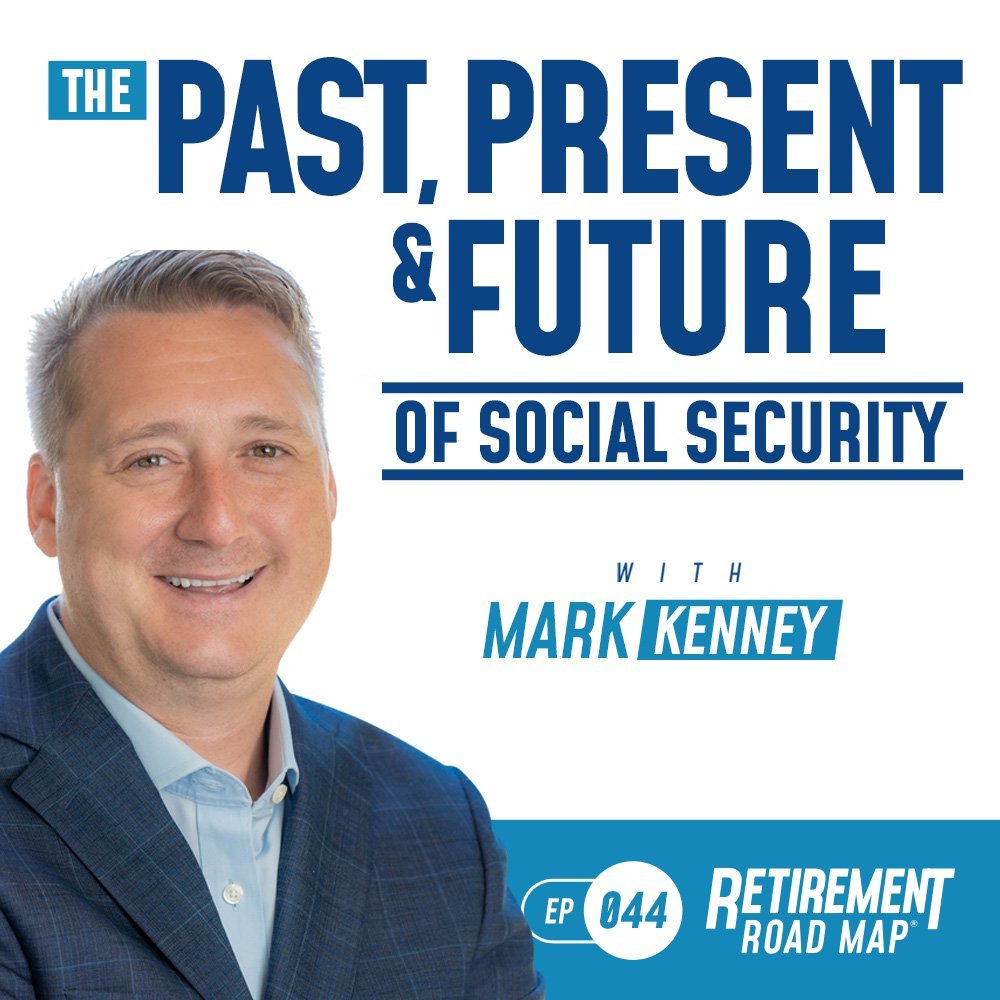At SHP Financial, we help our clients with many common or technical questions such as, “What is a required minimum distribution?” or “What’s a Roth conversion?” However, one of the most popular questions we hear is, “How much money do I need to retire?”
It’s a difficult question to answer because the magic number isn’t the same for everyone. There’s so many factors involved like inflation, bear markets and healthcare expenses to name a few, that just thinking about it is stressful and brings out a lot of fear and emotions for many people.
With that in mind, today’s episode is all about the process we go through to figure out those magic numbers. Ultimately, it all boils down to creating a plan and having some honest conversations about what an ideal retirement should look like. With proper guidance, you’ll enjoy the peace of mind that having a plan provides so that you’ll worry about retirement a lot less and perhaps even enjoy the last few years of working a lot more.
In this podcast interview, you’ll learn:
- Why the decision to stop working and retire is as emotional as it is financial.
- The danger of winging your retirement without a plan in place.
- How to determine the cost of your lifestyle and make adjustments after you stop working.
- Why so many clients find work much less stressful once they realize that they can safely retire.
- The important questions to ask to help ensure you get the most out of your retirement.
Inspiring Quotes
- “One of the keys to happiness is having purpose, having a reason. It’s making a change and making a difference and making sure that there’s something that drives you every day.” – Matthew Peck
- “What is the true cost of retirement? The answer is not how much I need to save in retirement, it’s how much do you spend in retirement.” – Matthew Peck
- “Empowerment to be able to step away from a job, a career, a business, and be able to retire the way that you want in a comfortable manner, the only way you’re going to feel that is to have a plan.” – Keith Ellis Jr.
Matthew Peck: Welcome, everyone, to another edition of SHP Financial’s Retirement Roadmap podcast. I’ll be your host today, Matthew Peck, and I’m joined with my fellow business partner, Keith Ellis, who we’re still working 21 years away. And I guess we’re slowly getting better.
Keith Ellis Jr.: Yeah, yeah, slowly getting better, refining, and continuing to build plans and look at how people do what they want to do when they’re done with their working years. And that’s called retire.
Matthew Peck: Well, it’s so much fun, too, because sometimes I’ll ask people, they’ll say, “Okay. What does make SHP different and whatnot?” And sometimes I do talk about experience in the sense that we’ve been here now for, again, over 20 years and going through the ’08 and then COVID and this current inflationary time and all the different administrations. Obviously, I’m sure you get questions about politics a lot as well.
Keith Ellis Jr.: Every four years.
Matthew Peck: Yeah, to be precise. And I think in that time too, Keith, we get I think there are certain common questions that we get. Sometimes it’s more on a technical question such as, “What is a required minimum distribution?” or, “What is a Roth conversion?” when it comes to our tax planning side of it. But I think at the very top or one of the more common questions that we get a lot that I really wanted to dig into today is, how much do I need to retire? I think we get that question a lot, where clients come in and they say, “Okay. I have this amount of money saved or that amount of money saved. Do I have enough to retire? What is that magic number?” And so, what I wanted to do over the next 30, 35 minutes, depending on how long I have your expert knowledge with us, but really dig into that because I think it’s a different number for different people but it’s not just a financial number.
I mean, I think there’s emotional numbers with that or some people are comfortable in retirement and some people are not, or some people take some time to get comfortable and other people are once they retire, they never look back. And then again getting people over that hump to say, “Hey, do I have enough? What is that magic number?” And I think at the same time, too, we could also spend some time talking about how SHP helps identify that number for each individual client that walks in whether it’s here in Plymouth or Woburn, Hyannis, or some of our satellite offices. So, kind of using the time to really dig into that question I think will be great. So, Keith, how often do you get asked that question of how much do I need to retire? And where do you start? How do you start to break that down for a client?
Keith Ellis Jr.: Yeah. I mean, every person that comes in the door, that’s kind of the big question that they’re asking is I’ve been working 20, 25, 30, 35 years. I’ve saved X number of dollars. Is this enough for me to be able to stop working and retire? And like you said, it is both a financial but also an emotional decision. So, I always start with the fact that you need to have a plan when you set out into retirement. You can’t wing it. You can’t just go into retirement saying, “Hey, I have a 401(k), I have a 403(b), I have a couple of other accounts, whatever it is, and I’m just going to start taking distributions from whatever account haphazardly,” for lack of a better way of putting it. You need to have a plan. And I think that’s really the first step.
I mean, we go on vacations and things like that with our families. What’s the first thing that we do? We plan those vacations, right? And that’s two weeks of our lives or ten days of our lives or seven days of our lives. Now, we’re talking about 15, 20, 25, 30 years of our lives and there are so many people that step out into retirement, and then all of a sudden they’re like, “Wait, wait, wait, wait, wait, I need to actually, you’re right, I actually do need a plan.” So, they come in and visit with us or other advisors around to put together that plan. And I think the first thing you need to do is identify what you want your retirement to look like. That’s a lot of the questions that we ask upfront. It’s not necessarily, “Hey, how much money do you have? How much have you saved?” It’s really painting the picture of what we want the next 10, 20, 30 years of your life to look at because that’s going to come back to determine what your spending is going to look like.
Because, I mean, I’ve had folks that have saved $300,000, $400,000 and they’re going to be perfect through retirement because they don’t live a very extravagant life, and that’s the life that they want to live, right? Then I have people that have millions and millions and millions of dollars saved. And they’re still continuing to work because they don’t have enough to afford their lifestyle still. You know what I mean? So, it really comes down to what is your lifestyle going to look like in retirement. And starting to put together the B-word, and then no one likes to hear it, but it is important to have and that’s a budget. No one wants to live on a budget, but it really helps benchmark or start to put a plan in place as to spending.
Now, one of the things that SHP does in my opinion and this is something we’ve really done is say, “Okay. Look, you have a budget. You’re spending your household expenses,” but we want to challenge our investors or challenge the families we work with to live a meaningful retirement. Like, you’re not going to sit on your couch all day and watch TV in retirement. We want you to enjoy your retirement, really paint that picture, and help them paint that picture, like I said, over the next 20, 30 years of their life to say, “Look, there’s still meaning beyond work.” We’re going to transfer that effort into something else, whether it’s grandchildren, family connection, vacation, vacation with friends, whatever it is, every community service. Everyone has a different passion. And it’s up to us as advisors to show them that path but also bring that out of them. Does that make sense?
Matthew Peck: Absolutely. No, and there are so many things that you spoke about there that I really kind of wanted to both underscore as well as sort of come back to and develop a little bit. The first part you talked about winging it. I mean, that to me is so nervous and so I couldn’t even imagine someone retiring without a plan. Maybe it’s because that’s what we do every day is set people up on plans. And so, I mean, or maybe it’s just because…
Keith Ellis Jr.: Whenever we go on vacation, it’s nice though because my wife does the planning and I don’t have to so this is fantastic.
Matthew Peck: Well, that’s the thing. That’s like you need an advisor.
Keith Ellis Jr.: Yes. I need a vacation advisor.
Matthew Peck: Right. Exactly. You definitely need somebody. But that’s the point. You need someone to do that for you because like, literally, if you’re making that massive change in that massive you’re walking into your boss’s office and you’re about to tell your boss or if you’re self-employed, that’s great too, but you’re about to tell your boss to say, “Look, I’m retiring.” And making that change if, I mean, it’s like how you would do that without being stressful, without sweating buckets versus going in there with the plan and being like, “Okay.”
Keith Ellis Jr.: And like know when you’re going to be okay.
Matthew Peck: Yeah, I ran all these numbers. I took a look at, okay, what if there’s inflation and what if there’s a bear market? And if you crunched all those numbers, then you’re going in with this almost supreme confidence to say, “Yes, I’m ready for this. I’m ready for retirement. I took a look. I did all my due diligence, right? And I’m not winging it,” where when other people, if you do that and if you retire without a plan in place, I just, I mean, God bless you, I just don’t know how you do it because that makes me nervous just thinking about it.
Keith Ellis Jr.: And I think you said it right. You hit the nail right on the head. Having a plan provides confidence. That’s one of the things that I experience with the families that I work with is you can see as we start to meet with them time and time again and they start to step from the working years of their lives into the retirement years of retirement, you can see the confidence that they have as they start to see the plan that we’ve built them unfold. And they’re like, “Wow. This is really working.” You know what I mean? And I can actually spend what I want to spend and do what I want to do and enjoy the life that I want to enjoy. It’s empowering. It provides confidence, and the great part about a plan is you can always go back and revisit that plan to then again, things start to creep in your mind, “Hey, the market’s down,” or, “Hey, so you know, this is going on in my life,” or, “Hey, we’re about to make a move, a big move in our life, buy a second home,” whatever it is, you can always go back to that plan, revisit that plan, rebuild that plan to again instill that confidence ongoing.
Matthew Peck: Well, that’s what I want to say, that was the second point. I’m glad you went back to it is the fact that there are different stages to retirement. Now, we certainly want to make sure that people have a plan in place and that, as you said, that we’re constantly revisiting it. But I think everyone needs to understand when it comes to, “Okay, how much money do you need when you retire?” where you’re going to need different amounts at different stages or something along the lines about how they say that you have like your go-go years in retirement, you’re slow-go years in retirement, and then your no-go years in retirement. Right? And so, understanding the fact that retirement itself is going to change, I mean, yes, we’re going to have this to show you what it looks like over the next 10, 15, 20, 30 years but we’re also in the back of the advisors minds, aware that there are going to be these stages and there are going to be different expenses and budgets and needs as mentioned, or also fun stuff that’s going to happen, like maybe it is a second home, along those same lines.
So, understanding that not only is it plan but it’s constantly being revised and updated because you will be entering different stages in retirement. But let me also talk about the last thing that you mentioned, to which I think is by far one of the most powerful things is that one of the keys to happiness, to overall happiness is having purpose, right, having a reason. And it’s like making a change and making a difference and making sure that there’s something that drives you every day. And so, obviously, when you’re working, it’s relatively easy. I mean, your purpose is to make money and to save or to work on your career, whatever that may be but making sure that you think in that type of thought process in retirement. And I love how you said like, “Look, we try to challenge our clients to bring that out in them,” because, yeah, we might be able to set you up a financial plan, but if you’re not emotionally happy, then that part is going to be missing.
So, I did want to really talk about that. So, now let me talk about more on brass tacks because you mentioned the budget aspect of it. Now, I would say that there are different ways for people, I mean, I guess let me put this right, Keith. I mean, certain clients come in and they have their spreadsheets and they have everything all itemized out, which is fantastic. And I think it’s honestly a budget. It’s more about, I’m trying to think of a better word for it, but it’s almost like accounting. We just need to know how much it’s going to cost. And so, as I said, some of our clients walk in and they have it all buttoned up to a tee and they have every single expense. They’ve done all their homework, which is great. Now, a lot of people don’t. They don’t have that spreadsheet. They don’t have that list of each individual expense. How do you help them figure out what the cost of their lifestyle would be?
Keith Ellis Jr.: Yeah. I usually take a look at their current income and we start to really think. And maybe they go home. They say, “Hey, look, I really want to do this exercise. I want to go back in time and look at what we spent over the last…” Many times, that’s the case because these people want to come up with a firm number or at least a pretty darn close to a firm number of what they had been spending. But we say, “Okay. Look, what is your current income? What are your current expenses that like maybe like a mortgage that could be falling off? Or are you paying health care?” all these different things, and you kind of come to a number in a meeting. I’ll be honest with you. Most of my clients kind of target right around $100,000 a year net income. I don’t know if that’s true for you but most people, that’s kind of where they’re comfortable, whether they’re making 250,000 a year, 300,000 a year now, or whether they’re kind of making $80,000 a year now.
So, a lot of times we’re starting with a projection, not necessarily knowing its exact, but as we start to work through the process, we really do want to hammer in and get a little bit more under the microscope of the exact. It’s really hard to say, “Hey, look, you’re going to be okay for the next 25, 30 years of your life, unless we do have those numbers.” You know what I mean?
Matthew Peck: Yeah. No, it’s true. And I think that’s also and I think maybe that’s why I go back to the stages and about how we constantly revise and update these numbers because sometimes it’s hard. I mean, sometimes it’s hard to say, “Okay. Well, this is my budget, my spending now while I’m working, but what’s it going to be like when I’m retired? And what’s it going to be like… Is it during my go-go years?” And I do love the idea of the planning of being able to be like, “Okay. How much itemization do we want to do? I mean, let’s kind of have your living expenses. And you’ve seen that in the spreadsheets in sort of the SHP portal for any of our existing clients. They know what this report looks like but we’re able to put together what’s called a cash flow report. That’s the fancy term. We do like to call it, more specifically, as the income plan.
Keith Ellis Jr.: Yes.
Matthew Peck: Right? And so, in that income plan, as you were saying, we’re going to take a look at your income, take a look at your Social Security and other forms of income, pension if you’re so lucky, or have obviously paid into it. But then under the expenses tab, people can set it up any way they want. So, for example, sometimes for some clients they’ll have like your standard of living expenses that will go on in perpetuity for the rest of your life but then they’ll kind of create a separate column for other expense flows. Now, that could be a new car every five to seven years. It could be a vacation and say, “Look, I’m going to travel like crazy from 62 until 72, as an example, right? Sometimes it all gets merged together so that people will separate their mortgages if they have it because your mortgage will eventually fall off unless you’re doing a brand new 30-year mortgage as you enter retirement.
And so, having that placeholder and then being able to obviously model it out but we want to start somewhere. We want to get something like kind of pen to paper. So, now we can start to track it. Were we right or were we wrong? I mean, and I think you’ve had experiences like this where clients like, “Oh, don’t worry, Keith. I only spend $10,000 a month.” And then what happens in a year from then?
Keith Ellis Jr.: Yeah. “We need an extra two,” you know, and it’s like, “Wait a minute. Let’s revisit this. Let’s make sure that fits.” And that’s the beauty of having that cash flow analysis. What I love about it, Matt, and I tell people, it’s a living, breathing plan that updates every day. So, as we meet with our clients and the families we work with ongoing, we’re revisiting this plan to make sure we’re on track. How do you know? And then if we’re off track, we make adjustments or if we say they’re only spending X dollars and their portfolio is growing, it empowers them to spend more, give more, give it to their kids more, their grandkids more, 529 plans, whatever it is. And we start to create different strategies off that or if we start to see the portfolio come down a little bit because you’re spending too much, we might have to have that conversation of tightening. But how do you know?
You have to have it earlier and be on top of this stuff because otherwise things get off track and it can create some really bad situations. That’s why, again, having a plan is extremely important. I had a client walk in, a family that I’ve been working with. When they first came in about a year and a half ago, they were both 60 years old, wanted to retire at 62. And they were just starting out but they actually came in with the spreadsheets, the budget. They needed, like I said, about $100,000 a year of net income in retirement. And they projected they were going to be about $70,000 a year from Social Security at full retirement age. That’s the numbers that it stated but they were maybe thinking about taking Social Security at 62 when they retire. So, what we did is we built that cash flow analysis to say, “Okay. Look, if you take Social Security at 62, here’s what your portfolio is going to look like over the long run.”
And then what we’re able to do is compare that to waiting to their full retirement age. What that did is it added an extra $400,000 in value to their portfolio by waiting. Now, obviously, there’s a lot of unknowns there, health, God forbid, something happens to one of them. But if you look at that and you dissect that information and you look at those two scenarios, I guess what I’ll say is having a plan helps you make better decisions.
Matthew Peck: Absolutely.
Keith Ellis Jr.: Better decisions around when to take Social Security, better decisions maybe around having a pension or a lump sum, better decisions around health care. Are we building in a separate expense for health care? What does that look like when it comes to our Medicare expenses? Do we need long-term care? Can we afford long-term care? Because a lot of people have had long-term care experiences, they want to account for that and have a plan set up for that. Is it affordable? Well, how do you know that? You know what I mean? So, taxes, which we’re going to get into here in a minute as well because when I was modeling this out for them and then retiring at 62, we also had to show them, “Hey, if…” And they were going to be fine, plenty of money for the rest of their lives based upon the 1.5 million that they had saved. They could have retired right then at 60.
How empowering is that, by the way? Someone comes in, meet, you build a plan for them, and you show them, “You’re going to be fine if you retire at 60, 61, 62, whenever you want. You now control your future rather than work-life controlling your future.” Talk about empowering people to live a better life, in my opinion, or a more stress-free life. Because if you’re not stressed about work and you don’t technically “have to go to work,” now you want to go to work, that’s a different experience altogether.
Matthew Peck: Well, it was. Sorry to interrupt. It brings up one of my favorite stories I love telling about a client. I’ll just call him Bob for now. But I remember the first time I met Bob. He came to the office. He was all stressed out, hair all straggly and everything else along those lines. And he’s like, “Man, I got to retire. I got to retire.” Just like, “How do I retire?” I’m like, “Okay.” Well, we went through the process. He’s like, back to Bob. Bob says, “I want to retire as soon as possible.” So, we go through the process, which I’m going to come back to because I do want to talk about sort of like the next step about the net $100,000 or whatnot. But, okay, back to Bob. Bob’s all stressed out. Sit down with him a second, third, fourth time, develop a plan, and say, “Hey, Bob you can retire. You’re good, man. You don’t have to put up with the stress anymore. Life’s too short,” you know, all of those kind of cliche but true adages.
And so, I was like, “All right, Bob, you’re good to go. Go ahead and put your notice in.” Six months later, nine months later, Bob comes in for a review. I’m like, “Okay, Bob, are you retired? What are you doing now? Are you golfing? Are you gardening? What are you up to?” He’s like, “Oh, I didn’t retire.” I was like, “Bob, you first came in, you’re like stressed as, you know, out of your mind.”
Keith Ellis Jr.: I have many clients like this, which is fine.
Matthew Peck: Yeah. And now Bob’s like, “Well, now that I know I can retire, suddenly work is a lot less stressful.” And it was just like the fact that we were able like the plan that we were able to show him the light in the tunnel. Now, he could keep on going through that tunnel all he wanted. He could get off the next day if he wanted. But he said about how empowering that was, and just that brought such relief to Bob knowing that he could go to any point. He still wanted to work but he now knew that he could go at any point, had a plan in place, and that that alone was enough to put a smile on his face and get him up every Monday morning.
Keith Ellis Jr.: And to kind of circle that, it’s such an empowering feeling for folks that you can almost see the weight lifted off their shoulder as he’s sitting across the table from you and the happiness in their face to say, “Wow. All these years I’ve been kind of ‘doing the right thing’ and it’s paid off. And I know it’s paid off because you’ve shown me it’s paid off. And I don’t have to keep doing what I’m doing. I want to but I don’t have to.” So, I always say, if your boss says something, do the wrong way, you could say, “See you later.” You know what I mean? It’s one of those things. Like I said, it’s an empowering feeling. But to circle back to that client I was speaking about earlier, okay, so now we know that they can retire at 60, 61, 62. They’re going to be fine for the rest of their lives. Now, it’s up to us as advisors to look at this plan that we’ve built them in a holistic manner.
And I think our SHP Retirement Roadmap process, it’s all about building a holistic plan. I always say we’ve built the castle, now we need to build the moat around it. What are some things that could penetrate the castle or kind of hurt your retirement? Okay. One of them is taxes, right? So, a lot of people have saved money in pre-tax assets. So, you’ve saved in IRAs. You have saved money in 401(k)s, you’ve saved money in 403(b)s because that’s what we’ve all been told to do. Nothing right or wrong about that but that’s kind of where the majority of people sit. Well, as you retire, if the government were to sign into law a new legislation which increased taxes say 5%, 10%, 15%, well, now you’re withdrawing that much more to meet that net number at the number that you need to live your life, you’re depleting your assets a lot quicker than you once expected.
So, it’s our job as advisors each and every year to meet with the families we work with, you know, most of the time, two, maybe three times a year along the way to identify some of these issues that we see in the future and start to cure them now. So, one of the things that you mentioned earlier was the idea of starting to transition money from IRAs to Roth IRAs. Take that tax target off the back of those assets. Now, you have to do it methodically over time because we don’t want to jump through all these different tax brackets, increase health care costs, so on and so forth. But if you’re not having those conversations with your advisor right now, you’re doing yourself a disservice because it’s kind of just coasting through retirement. That plan isn’t as fine-tuned as it could be because eventually, at some point, taxes, in my opinion, have to go up with the rate that we’re spending and the national debt, so on and so forth. I mean, what is the low-hanging fruit? It’s pre-tax assets. How does the government get more? A simple stroke of a pen. It’s that simple, in my opinion.
Matthew Peck: Well, and I think that’s why it’s so crucial to go back to the cash flow on the income plan. And now I’m going to put you on the spot here in a second too, is the fact that it has to be that $100,000 that we talk about, about that spending has to be net of taxes. And I think you kind of mentioned that earlier. I’m like, “Okay, I really wanted to emphasize that,” is that when we are building out that income plan and how much do I need to retire and whatnot, we want to make sure that spending is sustainable both for taxes and inflation. So, those two things happen. It has to be that $100,000. It has to be net of taxes. It has to be net of inflation, or at least adjusted for inflation through the next couple through your retirement. And so, okay, so now people are going to ask the question, they’re going to say, “Okay, what’s the magic number?”
So, let me take that scenario we’re kind of painting. Client needs $100,000 of net income. They have $40,000 of combined Social Security, which means they have an income gap of $60,000 per year. To sort of repeat, the client is $60,000 per year, net of taxes, in order to live the lifestyle that they’ve dreamed. How much should that client have saved?
Keith Ellis Jr.: You know, that’s a great question. And the one thing I would say to that is, or the one thing I would ask them is that $100,000 in this scenario, you “getting by”? Or is it, are we building in these other expenses, like you said earlier, a new car every five, seven years, health care costs? My guess is probably 1.5 million to 2 million we probably get that done. Obviously, I would want to run it through the cash flow analysis but my guess is probably that’s where we would target because you always want to build a buffer. You always want to have a buffer because things do come up. But to kind of circle back to what I was speaking about earlier is, one, it doesn’t have to be $100,000 a year net. I have some clients that say, “I’m going to be fine and I’m going to be able to do everything I want to do $60,000 a year net.”
Like I said, I have other clients that say, “Look, I need $140,000 a year net.” That’s, to me, I don’t want to say the fun part, but the interesting part about this job or what we do is everyone’s situation is completely different. And it’s fun to show them and it’s empowering to show them what their situation looks like on paper and then building different scenarios. A lot of people have different concerns. Well, the good news is, okay, here’s your plan. Let’s address those concerns in different scenarios and see how your plan holds up. Right?
Matthew Peck: Well, they’re saying… I’m sorry to interrupt, Keith, but I love how you kind of put it because, you know, so here you are. I put you on the spot. You answered the question, which is great, anywhere from $1 million, $1.5 million to $2 million. No. And I’m going to go back to that number because I want to sort of ask your opinion on an old rule of thumb for retirement. But I love how you just said, “Look. But wait a second. It’s not necessarily the number that you’ve saved. It goes back to the budget. It goes back to how much you spend and how much of that lifestyle that makes you the happiest.” What is the true cost of that? So, the answer is not how much I need to save in retirement, it’s, no, how much do you spend in retirement.
Keith Ellis Jr.: Yeah. And that’s what a lot of people…
Matthew Peck: They really need to figure that out first.
Keith Ellis Jr.: Yeah. We always say a lot of people focus on the wrong number. I’ve had people come in and say, “Hey, I need to save 2 million.” And I’m like, “Okay, why?” And then we start to look at their budget. They could have retired three years ago.
Matthew Peck: Yeah.
Keith Ellis Jr.: You know what I mean? It’s very interesting that people have kind of that mindset where they’re almost focusing on the wrong number because there are two things you’re never going to get back, health and time. I’ve experienced it in my own life with personal experience with my father’s. You know, you will never get back the ability to spend time with family, spend time with your loved ones, spend time with your grandkids. And there’s no guarantee that your health is going to hold up to the next day. So, again, talk about going back to that empowerment, the empowerment to be able to step away from a job, a career, a business, and be able to retire the way that you want in a comfortable manner, the only way you’re going to feel that is to have a plan.
Matthew Peck: Yeah. Well, and I think too to go back to the idea of, okay, $1 million to $2 million, and why a plan is so important is because there was an original rule of thumb or old adage that was very popular when we were sort of first entering the field. And we still get a lot of questions about it, too, which is what’s called the 4% rule, right? Where it’s like, okay, if you are withdrawing 4% or less of your assets on an annual basis, then history shows that you should be fine. And I think that’s kind of how you came up with that idea of anywhere from $1 million to $2 million. If you are spending $60,000 per year, net of taxes, net of inflation, that falls right within the 4% withdrawal rule. Let me backup a little bit. I mean, do you talk about that much with clients? I mean, sometimes we get asked it. I’m just curious if your opinion on that in general and how much that plays a role in your planning.
Keith Ellis Jr.: Here’s the problem. I mean, you said it, right? And it’s ‘should.’ Should be fine. I mean, plain, you should get there. Like, no. That’s not how I would want to retire. That’s kind of not how I want. I want to know that I have a… You know what I mean?
Matthew Peck: Yeah,
Keith Ellis Jr.: I want to see it on paper. So, whether you can afford to execute the 4% rule, which is a lot harder today in the interest rate environment, maybe not now, but over the past…
Matthew Peck: It was over the past 20.
Keith Ellis Jr.: Yeah, past 20 years. It was really almost impossible to kind of go with that methodology. And are interest rates going to stay as high as they are now? Probably not.
Matthew Peck: Well, and that’s the thing too. Sorry to interrupt. I mean, it’s just the whole idea of 4% is fine. We’ll take, okay, interest rates move. And if they’re going up, okay, well, maybe that makes a little bit more viable. But if we’re going down and if we enter another two decades of low interest rates like we saw during our working careers, then suddenly that 4% under pressure.
Keith Ellis Jr.: So, to answer your question, do people bring that up from time to time? Is it a methodology that we use? Not really. So, we believe that you need money that’s dedicated for safety or emergency money or bank, your rainy day fund, money that’s dedicated for income, whether that’s interest, dividends, yield, annuity, whatever it is. The most efficient path to get you what you need because you said it earlier, people don’t really worry about their spending while they’re working. Why? Because they have income to support their lifestyle. Well, don’t you want that in retirement?
Matthew Peck: Yeah, right. Exactly.
Keith Ellis Jr.: That exact same thing. I mean, I call it mailbox money. Don’t you want to know that, hey, no matter what’s happening in Wall Street, Washington, DC, or around the world, that check’s coming to support your lifestyle? Now, how we get there is different with every family that we work with. But it’s about efficiencies. And then once you have what I call their lifestyle protected, you have enough money in a rainy day fund, you have enough money to support the income for the next 10, 15, 20 years, accounting for inflation, accounting for taxes, the rest of the money is used to grow. Now, that growth bucket could be used for extravagance, it could be used for gifting, it could be used for inheritance, it could be used for whatever other goals that the family has. It could be used for protection, long-term care strategies, whatever it is that people have that concern, though, but it’s important to have purpose around your assets.
And that’s what I see the most is most folks come in, we’ve done a great job saving, and they just haven’t built purpose around what they’ve created. They’ve done a great job getting to where they are. It’s up to us and our team and our planners to put purpose around everything so then they know that they’re going to be okay.
Matthew Peck: Well, thank you. So, thank you so much. I mean, let me just sort of take this full circle and kind of wrap up, right? So, we began the podcast by asking the question that we often get, which is how much do I need to retire? How much do I need to save in retirement or for retirement? In our opinion, you’re asking the wrong question. That’s not the question. The question is, how much do you spend in retirement and what’s the difference? What is the income gap between your guaranteed sources of income such as social security, pensions, annuities, and that spending goal? So, to repeat, it’s not about how much you’ve saved, it’s more about how much you spend. And I love how you talked about the idea of the planning process, of what we do is that the results are different from everybody in the sense that everyone has a unique situation, everyone has unique goals, everyone has unique values or not to say unique values, but they have goals that are very specific to themselves and their families, their own health situation, their own parent situation.
Like, if they had parents that passed away at age 50 and they’re 60 right now, they might want to really live life up to the absolute fullest. Everyone, every family has different legacy goals. Obviously, their health is going to be an impact, as I mentioned, but the process, even though everyone is different, the process is the same, which is to not necessarily to identify how much you have saved but let’s start, sorry, step one is to make sure that let’s find out how much you spend, and then let’s see if your savings can support that and then through various stress tests like Keith had mentioned earlier. Like, what about a health care scare? What about taxes going up? What about a bear market, etcetera? And so, at the end of the day, we can answer that question.
We just had to start with the most important question first is which is what you spend. And then through the planning process, we can tell you whether or not you have saved. We can say whether or not that number is the right number for you afterwards. And during that process, we’re able to provide people comfort, confidence, knowing that they have done, that they’ve worked it through the machine, if you will. They’ve done all the due diligence. They’ve done all the number crunching. So, when they eventually make that leap, when they eventually retire, when they move on to the next chapter of their lives, which has been a long chapter, because if a lot of our clients, they started working when they were 14, 15 years old, and now they’re on to that new stage.
Now, ideally, we could help them find some purpose in life. So, whatever that may be, charity, family, travel, hobbies, whatever that may be, we’re also going to find them purpose to their investments. So, each investment has a specific goal and then showing them the big picture, knows that they have confidence to achieve those goals, their personal goals in retirement while we help making sure that they are achieving their financial goals with their assets. Thank you so much for your time and really, really appreciate it. And we’ll catch you the next time.
Certain guides and content for publication were either co-authored or fully provided by third party marketing firms. SHP Financial utilizes third party marketing and public relation firms to assist in securing media appearances, for securing interviews, to provide suggested content for radio, for article placements, and other supporting services.
The content presented is for informational purposes only and is not intended as offering financial, tax, or legal advice, and should not be considered a solicitation for the purchase or sale of any security. Some of the informational content presented was prepared and provided by tMedia, LLC, while other content presented may be from outside sources believed to be providing accurate information. Regardless of source no representations or warranties as to the completeness or accuracy of any information presented is implied. tMedia, LLC is not affiliated with the Advisor, Advisor’s RIA, Broker-Dealer, or any state or SEC registered investment advisory firm. Before making any decisions you should consult a tax or legal professional to discuss your personal situation.Investment Advisory Services are offered through SHP Wealth Management LLC., an SEC registered investment advisor. Insurance sales are offered through SHP Financial, LLC. These are separate entities, Matthew Chapman Peck, CFP®, CIMA®, Derek Louis Gregoire, and Keith Winslow Ellis Jr. are independent licensed insurance agents, and Owners/Partners of an insurance agency, SHP Financial, LLC.. In addition, other supervised persons of SHP Wealth Management, LLC. are independent licensed insurance agents of SHP Financial, LLC. No statements made shall constitute tax, legal or accounting advice. You should consult your own legal or tax professional before investing. Both SHP Wealth Management, LLC. and SHP Financial, LLC. will offer clients advice and/or products from each entity. No client is under any obligation to purchase any insurance product.

